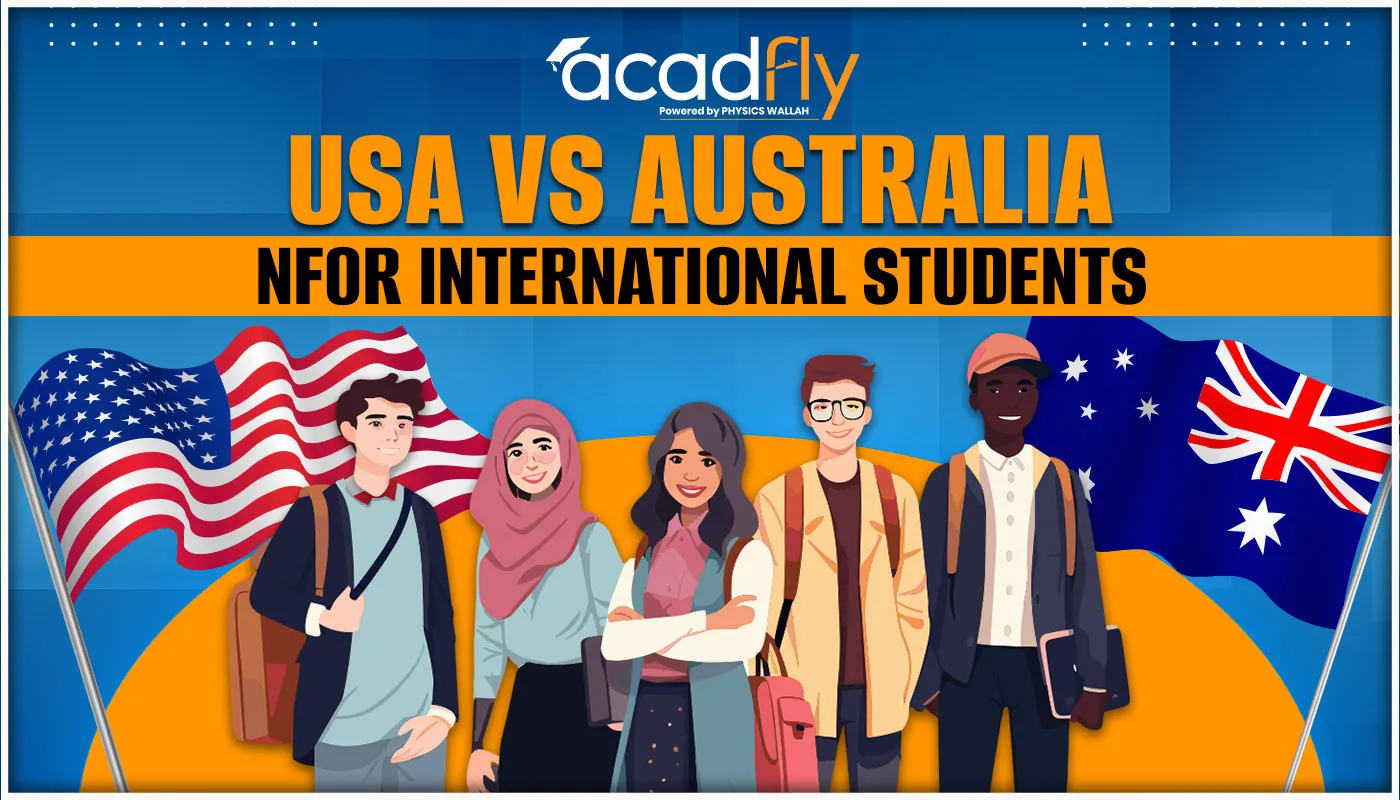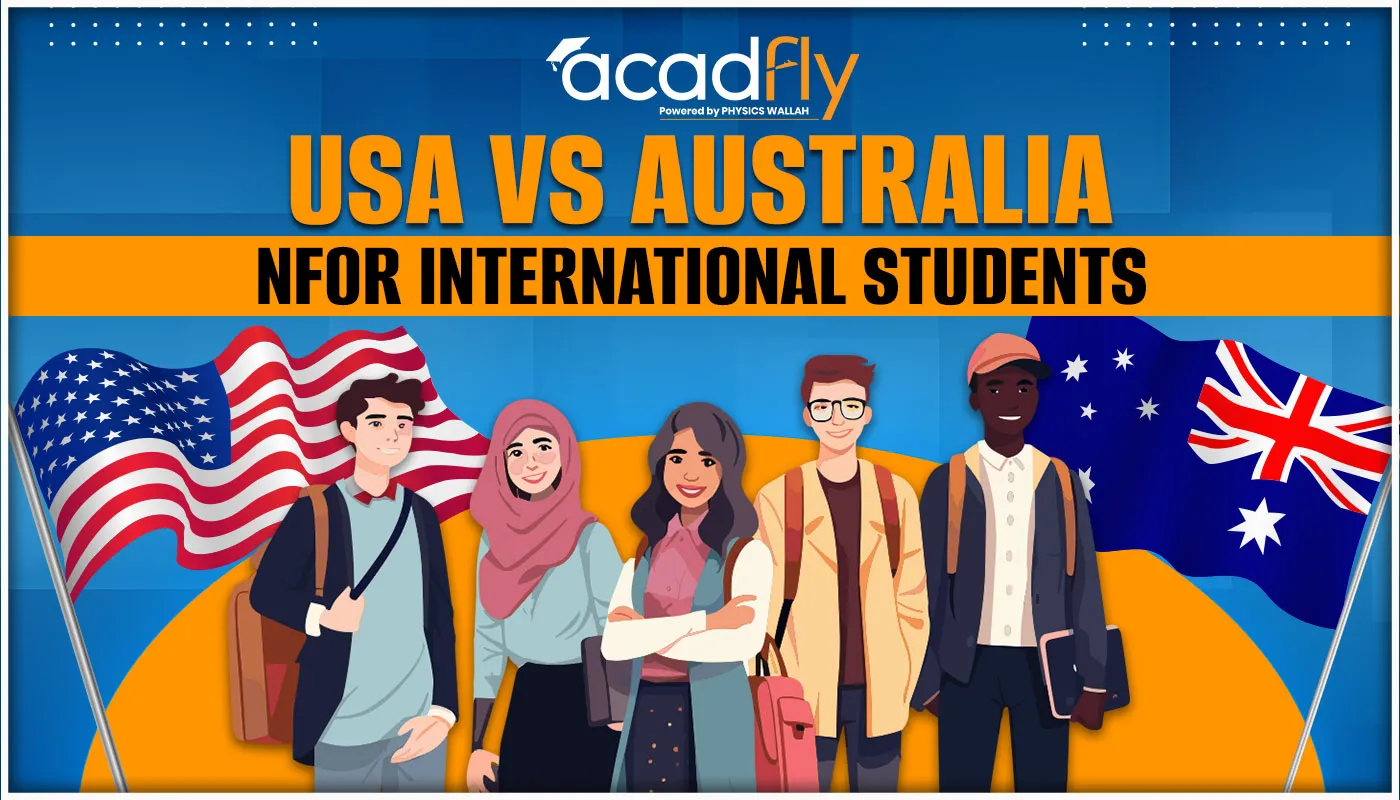


USA vs Australia: Which is Better for International Students? The USA offers diverse university options, strong STEM careers, and top research opportunities, while Australia provides a more relaxed lifestyle, lower costs, and clearer PR pathways. Your choice depends on your goals—pick the USA for innovation and academic prestige, or Australia for affordability, work-life balance, and post-study visa ease.
USA vs Australia: Which is Better for International Students? Indeed, this debate is often put forward by Indian students whenever they think of studying abroad, be it in the USA or Australia, both destinations having something unique to offer. Other factors that differentiate both countries are the duration of courses, variation in the amount of fees, scholarship availability, the ease to difficulty of securing a visa, and admission selectivity rate. So let this blog guide you through what studying abroad or perhaps starting your life in another country would mean in terms of a better quality of life or better opportunities:
Which is best - USA vs Australia?
It is between these two countries that world-class universities, both of them considered to be of the best in the world, offer something for international travelers in terms of education. But many variables should be taken into account before making the right choice between these two places. A detailed analysis is here for the comparison of studying in the USA vs. Australia, the top universities, cost of living, tuition fees, eligibility requirements, popular courses, average salaries, and scholarship opportunities.
The table below shows an overview of the USA vs Australia
Overview of USA vs Australia |
||
|
Feature |
US (America) |
Australia |
|
Cost (PG Courses) |
Higher range ($20k-$50k+ tuition/year) |
Slightly lower range ($20k-$45k tuition/year) |
|
Visa Ease |
F-1 Visa, must show strong ties to home. |
Subclass 500, GTE requirement. |
|
Post-Study Work |
OPT (12-36 months, STEM favored) |
Temp. Grad Visa (2-4+ years, broader scope) |
|
PR Pathway |
Very difficult, long, lottery-based for many. |
Clearer, points-based, competitive. |
|
Job Opportunities |
Strong in Tech, Finance, Healthcare. |
Strong in Healthcare, Engineering, IT. |
|
Scholarships |
Many options, highly competitive. |
Many options, competitive. |
|
Climate |
Highly diverse (snow, desert, tropical). |
Mostly warm/sunny, tropical north, temperate south. |
|
Culture |
Diverse, fast-paced, competitive. |
Relaxed, outdoor-oriented, multicultural. |
Educational Excellence
The rigorous academics and vast research opportunities are renowned for universities in the USA, such as Harvard, MIT, and Stanford. In Australia, on the other hand, the University of Sydney and the University of Melbourne have a very special importance in upholding the quality of education and are known mostly for research in medicine and sciences. Check the educational excellence comparison below to understand Australia vs the USA for International students better.
Of the over 5,300 universities in the US, some of the top-ranking include Harvard and MIT. Programs exist for almost every discipline, and the US boasts a flexible education system that allows for a personalized academic journey.
Australia: With 42 universities, including globally recognized ones like the University of Melbourne and UNSW Sydney, Australia is noted for its research output and practical teaching methods, particularly in science and technology.
Educational Cost in the USA vs Australia
Tuition fees compared to an Australian school are typically much higher for study in the USA, with living costs as well being significantly higher. Scholarships and other financial aid are available in both countries for international students.
-
USA :INR 25L to INR 80L
-
Australia:INR 15L to INR 30L
Cost of Living in Australia vs USA
Both countries are quite expensive when compared to most other places in the world, although they do have certain differences when it comes to the comparison of different costs.
The average monthly living expenses are approximately INR 98,000 ($ 1,172) in the USA, while INR 93,000 (AUD 1,723) in Australia, regarding housing, food, transport and all essentials, including student living costs.
Here's a detailed breakdown of certain costs in the USA vs Australia: This table highlights the variances in costs related to essential services and living accommodations in city centers, illustrating the slightly higher cost profile of the USA compared to Australia. Note that these costs can vary significantly based on the specific city and individual lifestyle.
Cost of Living in Australia vs USA |
||
|
Cost Category |
Average Cost in Australia |
Average Cost in the USA |
|
Mobile Phone |
INR 2,300 (AUD 43) |
INR 4,300 ($52) |
|
Internet |
INR 4,500 (AUD 85) |
INR 5,930 ($71) |
|
Transportation Monthly Pass |
INR 9,000 (AUD 170.65) |
INR 6,000 ($72) |
|
Basic Utilities |
INR 18,000 (AUD 334) |
INR 17,200 ($206) |
|
Rent in the City Centre |
INR 1.27L (AUD 2,377) |
INR 1.5L ($1,775) |
This table highlights the variances in costs related to essential services and living accommodations in city centers, illustrating the slightly higher cost profile of the USA compared to Australia. Note that these costs can vary significantly based on the specific city and individual lifestyle.
USA vs Australia Scholarships
Renowned universities and colleges exist in Australia and the US, and they award several scholarships yearly to international students, ranging from fully funded to partially funded scholarships. Let's take a glance at some of the most popular scholarships for both destinations.
USA vs Australia Scholarships |
|||||
|
Scholarships (Australia) |
Level of Study (Australia) |
Value (Australia) |
Scholarships (USA) |
Level of Study (USA) |
Value (USA) |
|
Carnegie Mellon University Scholarships |
Masters |
Up to $20,000 |
You Are Welcome Here Scholarship |
Undergraduate |
50% of Fees |
|
Melbourne Research Scholarship |
Masters / PhD |
Up to $14,600 |
Plater International Scholars Program |
Undergraduate |
Up to 27,000 USD |
|
Australia Awards Scholarships |
Undergraduate/ Masters / PhD |
Fully Funded |
Boundaries of Life Scholarship |
Postgraduate |
Up to 7000 USD |
|
Deakin Vice-Chancellor’s International Scholarship |
Undergraduate/Masters |
Fully Funded/ 50% of Tuition Fees |
Graduate Scholar Award |
Postgraduate |
Fee Waiver/Discount |
|
The University of Sydney Scholarships |
Undergraduate/Masters/ PhD |
Up to $40,000 per year |
Merit Scholarships for Incoming First Year Students |
Undergraduate |
Fee waiver/discount |
Student Visa Requirements -Australia vs USA
To apply for an Australian Student Visa, an account needs to be created on ImmiAccount, which is the online application system for DIBP. Visa application information can differ depending on your nationality and the course pursued. In general, you will need:
-
Confirmation of enrollment (your Electronic Confirmation of Enrolment)
-
Details of your Overseas Student Health Cover health insurance
-
Your Genuine Temporary Entrant (GTE) statement
-
Proof of your English skills
-
Your passport
-
Your visa application fee.
-
Parental consent and other auspice documents if under 18 years of age.
Student Visa Requirements in the USA
There are three principal categories of student visas in the USA:
-
F1 student visa: The college or university study in the USA or English study at an English-language institute.
-
J exchange visa: For taking part in a high school and university exchange program.
-
M student visa: For study or training that is considered nonacademic or vocational in the US.
To study in the USA, one must apply to and be admitted by an educational institution within the USA accredited by the Student and Exchange Visitor Program (SEVP). Upon such acceptance, the international student office would issue a Form I-20, a hard copy of the student's record in the Student and Exchange Visitor Information System (SEVIS).
USA vs. Australia: Which is Better for Living?
In deciding which country to choose, the USA or Australia, the weather and urban settings would really matter.
Weather: Diversity in climates-from the cold, snowy winters in the northeast to the warm, tropical weather in the south like Florida. While Australia caters to a more temperate climate across the board with milder winters and hotter summers for most parts of the country, two major cities, namely Sydney and Melbourne, have experienced longer periods of temperate weather throughout the year, sunny weather but sometimes wet and dry heat with colder periods in the winter months.
Urban Cities: The word "urban" in both countries has its own attributes and flaws. New York and San Francisco, for example, are simply among those mixed up with everything else an individual can find in the cultural diversity of a vast city, but crowding and the high cost of living are also part of such cities. Playgrounds for both of these cities come in the shiny urbanity of cities like Melbourne and Sydney; however, those cities fare extremely well in the rankings of livability existing today.
Overall, I prefer to USA vs Australia: which is better to live in has to do with personal preferences with regard to climate and city life, while both possess their own living and opportunities.
Which one to select - Australia or America?
So, US vs Australia for International Students - which is better? There's no best answer. It rather depends on what exactly you're searching for!
Choose the USA if: You want to have a great choice in universities, world-class research in many branches (especially technology), and a really active campus life with lots of sports and activities. You are interested in STEM careers and maybe are willing to have a little tougher path for PR.
Choose Australia if: You have a slightly more relaxed lifestyle with incredibly beautiful beaches and nature. You want clearer paths for post-study work and potentially PR, and also want high-quality education with a twist toward practical skills.
The choice of the USA vs Australia for studies depends largely on your personal academic goals, financial situation, and career aspirations. The USA offers a broader range of educational opportunities and higher potential salaries, while Australia provides a more relaxed educational environment with easier post-study work visa terms. Both offer excellent growth opportunities, making them top choices for Indian students.
USA vs Australia FAQs
Which is less expensive for studying in the US or Australia?
Which country has better job prospects for international students?
After studying in which of the two countries is it easier to acquire PR, Australia or the US?
Which country has a safer environment for international students?










